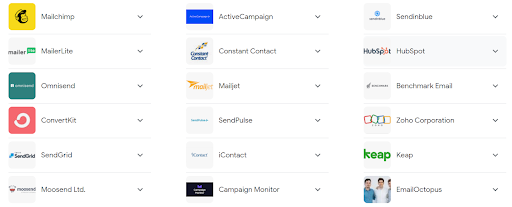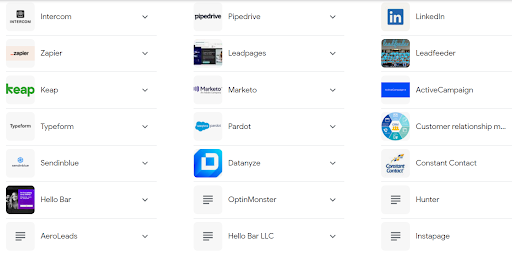[ad_1]
“It depends!” This is the best answer to any marketing question. And it’s true.
Everything in marketing can work—Instagram reels, podcasting, omnichannel marketing, embracing emerging social platforms like BeReal, authority content, authenticity, it all works.
But should your brand focus on every shiny trend? It depends! You don’t want to spread your budget too thin, but you wouldn’t want to miss out on a revolutionary idea just because it’s new.
Operational efficiency in marketing helps you streamline and optimize your activities for the maximum output using limited resources, time, and effort.
This article provides 10 practical tips for accelerating operational efficiency in marketing.
How can you Accelerate Marketing Operational Efficiency?
By optimizing your marketing operations, you achieve better results with limited resources and time. This ensures you accelerate your marketing operational efficiency.
Here are 10 tips you can use for a quick turnaround in your marketing efficiency and marketing ROI.
Streamline your Marketing Processes
Streamlining marketing processes is optimizing and simplifying various activities and workflows in your marketing campaigns and strategies. Think of it as doing the most with your team’s time and limited budget.
Streamlining marketing processes helps reduce errors and delays and enhances efficiency and quality output. You identify inefficiencies and improve the overall performance.
To streamline your marketing processes, you can:
Tip 1: Pay attention to the marketing channels that are not working
Carry out some audits to find out the channels that your clients prefer. Do you need to leave traditional marketing like radio and television? Is email marketing working better than social media?
You can also find out your competitors’ marketing channels and customer expectations. Basically, identify inefficiencies, eliminate unnecessary steps, and implement more efficient systems and channels to avoid wasting time and resources on things that don’t give the required result.
Tip 2: Implement automation tools for repetitive tasks
Automating repetitive tasks with tools frees your time for more strategic marketing activities. Here are a couple of marketing tasks you can automate:
- Email marketing– Use tools like AI email writers for drip campaigns, email list management, personalization and scheduling, autoresponders, abandoned carts, and other types of emails.
- Social media management– Tools like NapoleonCat, Buffer and Sprout Social can schedule and automate social media posts across multiple channels.
- Lead generation and nurturing– Automation tools can help you capture leads through forms on your website, advertisements, and landing pages.
- Content marketing– You can use content marketing systems (CMS) to schedule blogs and distribute content to different channels.
- Analytics and reports- Automation tools help you gather and analyze marketing data, track key metrics, and measure campaign performance to gain insights into the performance of your marketing efforts.

To implement automation effectively, identify the repetitive tasks that consume significant time and determine your automation goals. Explore the available automation tools and software that cater to your specific needs. Integrate the tools and continuously test and optimize while maintaining a human touch to ensure the processes align with your marketing goals.
Tip 3: Encourage collaboration between marketing teams and other departments
When marketing works closely with other departments, aligning marketing goals with the overall organizational goals becomes easier. You save lots of time going back and forth and making changes.
You also leverage other departments’ expertise and get unique perspectives and insights into your projects. This is great for creating well-informed marketing strategies.
Collaboration improves efficiency and resource allocation and enhances customer experiences while giving you that internal advocacy every marketer dreams of.
To encourage collaboration with other departments, you can:
- Encourage a culture of open and frequent communication with other departments. It can be as simple as regular email updates or well-detailed regular meetings.
- Establish shared goals and objectives by forming cross-functional teams fostering knowledge sharing and learning.
- Use collaborative tools and software to enable real-time collaboration and information sharing at any time and place.
Embrace Data-Driven Decision Making
Using a data-driven approach in marketing means that data and analytics drive all your decision-making. You collect, analyze and interpret data to understand customer behavior, preferences, and market trends.
Here’s how to embrace data-driven marketing:
Tip 4: Collect and analyze the relevant data
Data collection involves gathering all the relevant data from different sources, such as your website analytics, social media, sales record, and even customer interactions.
Here’s how to collect and analyze your marketing data:
- Clearly define your marketing objective– This includes your goals and objectives. They will determine the specific metrics and the relevant data points that you’ll use to measure the success of your marketing efforts.
- Identify your data sources– Where will you collect your marketing data? Data sources are points of customer interactions, website analytics, Google analytics, CTRM systems, social media analytics, etc.
- Set up data tracking measurement– these mechanisms will collect your data from your identified sources. E.g., UTM parameters for tracking campaign URLs.
- Cleanse and organize your data– This ensures accuracy and consistency. Standardize your data by removing duplicate, irrelevant, and inconsistent data points.
- Use data analytic tools to analyze and interpret the data- Tools will give you insights on trend analysis, how your market is segmented, and even correlation analysis. Analyze the data to identify patterns and trends and how they align with your marketing goals.
Once you get your analytics, make data-driven decisions and adjust your strategies and messaging based on the identified trends.
Remember to continuously monitor and optimize your marketing efforts by comparing your actual results with the set objectives.
Tip 5: Implement A/B testing to optimize your campaigns
With A/B testing, you compare two marketing campaign versions to find out which one performs better. This is a great tool for accelerating marketing efficiency since you determine the impact of each element and drop whatever is not working.
You also understand how the changes you implement impact your marketing KPIs. Here are the A/B testing steps:
- Clearly define the specific aspect you intend to test and optimize. E.g., email subject line, landing page design, call-to-action, etc.
- Create two versions of the variables you’re testing. E.g. for a banner, you can have two designs or two subject lines for an email. Everything else should be the same, except the variable.
- Split your audience into two groups and assign each group variant A or variant B to link your results to the specific variable.
- Run the test by deploying the set variants simultaneously and tracking your performance metrics. This may include open email rates, click-through rates, engagement levels, etc.
- Analyze the results and implement the winning variant by incorporating it into your marketing campaign.
With A/B testing, you optimize the best marketing strategy for operational efficiency and achieve better marketing outcomes.
Standardize your Lead Capture process.
Marketing should contribute about 30% of new sales in their companies’ sales pipeline— especially for SaaS companies.
However, marketing has anywhere between 5 and 10 touchpoints before successfully converting a lead. This may include advertising, email, website, social media, events, content marketing, etc.

Standardizing your lead capture process ensures you don’t lose potential customers at all touchpoints. You can achieve this by:
Tip 6: Centralizing marketing data governance
Data governance in marketing is how you manage your marketing data. It includes data collection, storage, usage sharing, and even compliance.
Centralizing your data governance ensures that marketing data is reliable when marketing teams make data-driven decisions such as customer segmentation.
By centralizing your data governance, you ensure all leads are captured, stored, and effectively managed, increasing your lead conversion and marketing efficiency.
For effective data centralization, marketing must collaborate with other departments and build a working strategy.
Tip 7: Standardize your lead processing form
Lead capture forms should be standardized to avoid complications. For example, if you have a different form for each customer touchpoint and build individual data flows from each form, you’ll likely end up with tens of different workflows.
Using the same form for each purpose, you can ensure each workflow is added to your CRM, ensuring that none of your leads is lost in the data capture process.
To standardize your lead processing into a single flow of data, you can take these steps:
- Identify all your data fields. E.g., name, email address, phone number, etc
- Design a centralized lead form template that ensures uniformity in data collection.
- Integrate your data capture with a centralized system or a customer relationship management (CRM) platform.
- Establish validation in error handling that ensures the accuracy of the data collected.
- Define your workflows and routing rules to ensure the right teams can ensure prompt follow-up for the collected leads.
- Implement automation and notifications and continuously analyze the standardized process and optimize.
With a standardized lead processing flow, you improve your marketing efficiency and data analysis of all your leads.
Optimize Resource Allocation
For operational efficiency, marketing teams must ensure the allocated resources maximize productivity, effectiveness, and return on investment.
Tip 8: Conduct a thorough analysis of marketing resources
To accelerate your marketing efficiency, find areas of strength and weakness in your resource allocation.
Here’s a quick way to analyze the usage of your marketing resources:
- Clearly outline your marketing goals and objectives. E.g., drive sales, enter new markets, and increase engagement.
- Conduct a resource audit. List all the marketing resources at your disposal and evaluate their effectiveness. This includes your budget, marketing team, tools, customer data, social media channels, etc. Identify areas of overspending and inefficiency.
- Allocate resources based on ROI to ensure you’re investing in activities that generate the highest returns.
- Identify resource gaps— how can you improve your marketing resources?
- Optimize your resources for better opportunities—leverage existing marketing resources to improve their performance continuously.
Tip 9: Empower your marketing team to improve efficiency
Empowering your marketing team enhances productivity and increases creativity and innovation while shortening the decision-making time.
When introducing new technology, consider adequate training for your team to reduce any agility caused by technology challenges.
You can empower your team by opening communication lines, delegating decision-making, and even providing the necessary tools to manage projects and social media channels and accomplish other tasks effectively. Also, encourage them with skill development activities and learning.
Tip 10. Create and nurture a culture of continuous improvement
A culture of continuous improvement prioritizes ongoing learning and adaptation. The marketing landscape changes every day, and your marketing team should be encouraged to analyze and test new avenues regularly.
Here’s how you can foster continuous improvement within your team:
- Encourage experimentation and risk-taking: Allocate time, tools, and budget for your team to experiment with. You can also create a safe environment for failures which is part of learning.
- Set developmental goals: Provide your marketing team with access to training programs, workshops, and online resources that encourage a growth mindset.
- Regularly review and optimize your marketing strategies: With set performance metrics, analyzing using regular reviews helps you identify areas of improvement.
Accelerate the Operational Efficiency of Your Marketing Team
Operational efficiency is just as important as creativity in marketing. Yes, we want our work to become viral, but at what cost?
Even with a lean marketing team and a limited budget, you can get more results. You also get your data right and make data-backed decisions.
Ultimately, your customers get a better user experience, especially during the lead capture process.
Ensure you leverage data, open your communication lines and encourage your team to try out new ideas. Finally, keep on monitoring and improving your marketing strategies for better results.
[ad_2]
Source link









